
In this step, you have an opportunity to add one or two total-body barbell exercises—the hang clean and the push press—to your basic program. Total-body exercises train major muscles of the upper and lower body simultaneously. These exercises involve quick, powerful movement, which is especially important for athletes involved in sports that have an explosive or speed–strength component such as sprinting, jumping, throwing, kicking, or punching.
Total-body exercises involve many muscle groups, and so a high level of muscular coordination is required to perform them correctly. Thus, if you are just beginning a weight training program, total-body exercises included in this step are not appropriate for you. To give you time to get stronger and learn general weight-training techniques, it is best to wait at least six weeks before adding one of these exercises.
If you choose to include a total-body exercise, perform it first during your workout. Because these exercises involve many muscle groups and require a high level of muscular coordination for correct technique, you need your muscles to be as fresh as possible. By performing a total-body exercise first, you can give attention to proper technique when you are least fatigued.
Unlike other steps, total-body exercises use free weights only, so you will need a barbell, weight plates, and two locks. Also, because the exercises are performed quickly and require extra attention to proper technique, they must be performed in an area away from others who are training. The area should have some floor protection in case you drop the bar quickly.
CAUTION: A spotter should not be used in these exercises because if something goes wrong, a spotter attempting to help or catch the bar could easily be injured or could cause injury to you. Do not ask someone to spot you in these exercises. If you experience balance or technique problems while performing them, simply allow the bar to drop while you back away from its downward path.
In the hang clean exercise, the bar moves from the thighs to the shoulders in one quick, powerful jumping movement. Initially, the bar is on the thighs, just above the knees, not on the floor. The upward phase requires a forceful, rapid extension of the hips, knees, and ankles followed by shrugging the shoulders and pulling with the arms to lift the bar to the front of the shoulders.
Begin this exercise with the bar at a midthigh position (called the hang position) (figure 10.1a, page 136). The techniques used to reach the midthigh position are the same as the preparation and upward movement (floor-to-thigh) phases described in step 2.
From this starting position, rapidly jump straight up (figure 10.1b, page 136). Completely extend the knees and hips. Think about jumping up, pushing through the floor, and fully lengthening your lower body. Immediately follow the jump with a strong shoulder-shrugging motion. Up to this point your arms should be like ropes that attach the bar to your shoulders. In other words, don’t bend your elbows yet to pull the bar up. However, at the end of the shrugging motion, your elbows flex, moving up and out to the side, to continue pulling the bar up as high as possible.

MISSTEP
The bar swings away from your thighs and hips.
CORRECTION
Concentrate on pulling the bar straight up and keeping it close to your thighs and hips.

MISSTEP
You rely on your arms to lift the bar off your thighs.
CORRECTION
Do not think about your arms doing any active work until after you have jumped up.
After the bar reaches its highest point (figure 10.1c, page 136), quickly shift your body under it to catch the weight while rapidly rotating your elbows down, then under, and then up in front of the bar as it touches your shoulders and clavicles (collarbones) (figure 10.1d, page 137). Do not let your elbows flex too soon; be sure to wait to do that until the shrug is at its highest point. As your elbows rotate around the bar, flex your knees and catch the barbell on the front of your shoulders. At the same time, your knees should act like shock absorbers to smoothly cushion the downward momentum. Never catch the weight with your knees fully extended because doing so could injure your back. Move your upper arms parallel to the floor, and after gaining a balanced position, finish the exercise by standing erect. Exhale as the bar lands on your shoulders.

MISSTEP
Your knees are straight when you catch the bar.
CORRECTION
Concentrate on flexing your knees, which provides “give” to your shoulders as you rack the bar on them to lessen much of the impact.
To return the bar to the midthigh (hang) position, slowly and with control “unrack” the bar and allow it to descend until it reaches your thighs (figure 10.1e, page 137). Simultaneously, flex your hips and knees to reduce the impact on your thighs. Your back should remain straight with your shoulders pulled back, and the bar close to your chest and abdominal area. After the last repetition of the set, squat down to lower the bar past your knees and back onto the floor.

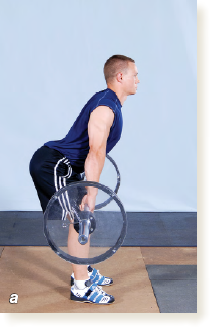
Preparation
1. Properly lift bar from floor to thighs
2. Start exercise from midthigh position
3. Inhale
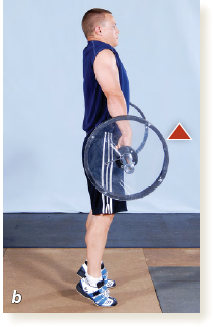
Jump and Shrug
1. Jump up explosively
2. Keep bar close to body as hips drive forward
3. Keep elbows straight
4. Fully extend knees and hips
5. Rapidly shrug the shoulders
6. Shrug as high as possible
7. Keep elbows straight
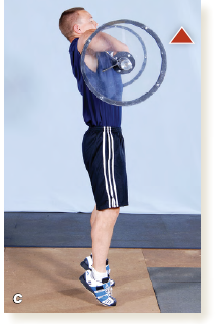
Highest Bar Height
1. Flex elbows and move them up and to side
2. Keep elbows above wrists
3. Continue pulling bar as high as possible
Catch
1. Rotate elbows down, under, then up in front of bar
2. Catch (rack) bar on front of shoulders
3. Flex knees and hips to absorb bar’s impact
4. Exhale
5. Move upper arms to be parallel to floor
6. Gain balance and stand up straight
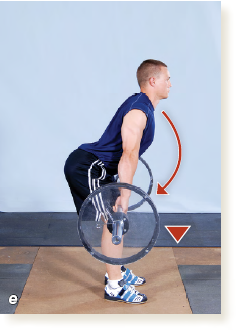
Unrack
1. Unrack bar from shoulders
2. Flex knees and hips
3. Allow bar to lower to thighs
4. Keep shoulders back and back flat
5. Keep bar close to chest and abdomen
6. Pause at hang position
7. Continue upward and downward movements until set is complete
8. After final repetition, allow bar to lower past knees
9. Squat to set bar on floor
10. Keep bar close to thighs, knees, and shins
Because of the complexity of this exercise, you may perform multiple errors in one repetition or develop technique flaws. Be diligent about perfecting your technique with this or any total-body exercise. Many of the common errors and corrections seen with this exercise are similar to those described in the “Lifting the Bar Off the Floor” section of step 2 (see page 18).
In the push press exercise, the bar moves from the shoulders to overhead in one quick and powerful jumping movement, similar to the hang clean. For this exercise, begin with the bar where it ends during the hang clean—at the front of the shoulders. The upward phase resembles the standing press (see figure 6.1), but the push press requires a forceful, rapid extension of the hips, knees, and ankles, followed by a pushing motion of the arms to lift the bar to a stable position over the head with the elbows fully extended. Inhalation occurs as the bar is returned to the shoulders between each repetition.
You will need to use the techniques you learned in step 2 and in the hang clean exercise (figure 10.1) to properly lift the bar off the floor up to the shoulders before you can actually begin the push press exercise. Alternatively, you can lift the bar out of a squat rack with supports already positioned at shoulder level.
The bar should be resting on your shoulders, clavicles, and hands (figure 10.2a). From this starting position, flex the hips and knees at a slow to moderate speed to move the bar in a straight path downward (figure 10.2b). This downward movement is not a full squat but rather a “dip” to a depth not to exceed the catch position of the hang clean. Do not lean forward or backward as you dip. Keep your torso erect and your head in a neutral position and do not change the position of your arms.
Immediately after reaching the lowest position of the dip, immediately reverse the movement by rapidly jumping up with your hips, knees, and ankles (figure 10.2c). Be sure to fully extend your knees and hips by the end of the upward drive. As your lower body joints reach full extension, slightly tip your head backward to allow the bar to pass by your chin (or else it will hit you). At this point (and not earlier) you begin pushing upward with your arms. To be sure that the bar travels straight up, be sure to jump straight up with your torso erect.
Catch the bar directly overhead with fully extended elbows and your hips and knees flexed to absorb the weight (figure 10.2d, page 140). Having your knees flexed provides give as you rack the bar on your shoulders, dissipating much of the impact. Your torso should be erect with your head in a neutral position directly under the bar, with your eyes focused forward. To keep your torso from leaning back when you catch the bar, think: Torso, head, and bar form a straight line. Once the bar is balanced overhead, stand up to a fully erect position by extending your hips and knees.

MISSTEP
Your arms extend unevenly.
CORRECTION
Keep both of your arms extending in unison by concentrating on the arm that lags behind.

MISSTEP
The bar is behind or slightly ahead of your head in the catch position.
CORRECTION
Catch the bar directly over the head with fully extended elbows, an erect torso, and the head in a neutral position.
To return the bar to the beginning position, slowly and with control allow it to descend until it reaches your shoulders and then stand up straight (figure 10.2e). Exhale as the bar reaches your shoulders and simultaneously flex your hips and knees to reduce the impact. Your back should remain straight with your shoulders pulled back and your chest held up and out. After the last repetition of the set, lower the bar to your thighs and then squat down to set it on the floor.

Figure 10.2 PUSH PRESS
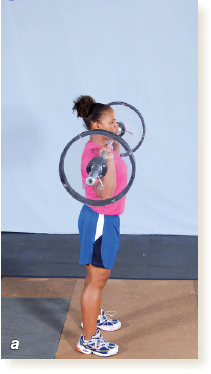
Preparation
1. Properly lift bar from floor to thighs
2. Properly lift bar from thighs to shoulders
3. Start exercise with bar at front of shoulders
4. Inhale
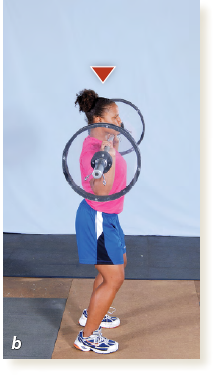
Dip
1. Flex hips and knees at a slow to moderate speed
2. Move bar downward in straight path
3. Keep torso erect and head in neutral position
4. Do not change position of arms
5. Do not dip too low
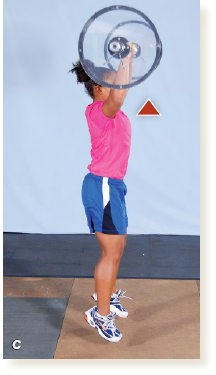
Drive
1. Jump up explosively
2. Tip head back slightly
3. Fully extend knees and hips
4. Push up with arms
5. Keep eyes focused forward
Catch
1. Catch bar directly overhead with fully extended elbows
2. Flex knees and hips to absorb bar’s impact
3. Keep torso erect and eyes focused forward
4. Gain balance and stand up straight
5. Exhale
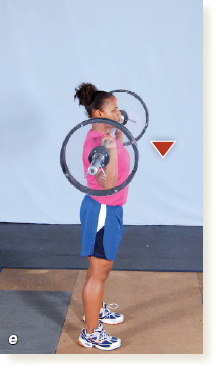
Lower
1. Allow bar to lower to shoulders
2. Inhale as bar reaches shoulders
3. Flex knees and hips
4. Keep shoulders back and back flat
5. Pause
6. Continue upward and downward movements until set is complete
7. After final repetition, unrack bar from shoulders
8. Allow bar to lower to thighs
9. Keep bar close to chest and abdomen
10. Allow bar to lower past knees
11. Squat to set bar on floor
12. Keep bar close to thighs, knees, and shins
Like the hang clean, this exercise can be a challenge to learn and master. You may perform several technique mistakes at one time. Common errors and corrections are similar to those described for the hang clean and the standing press.
Total-Body Drill 1. Choose One Exercise
After reading about the characteristics and techniques of these two total-body exercises and the type of equipment they require, you are ready to put to use what you have learned. Consider the availability of equipment and then select one of the following exercises to use in your program:
Hang clean
Push press
Write in “Total-body” in the “Muscle group” column on the workout chart and fill in the name of the exercise you selected in the “Exercise” column (see figure 11.1 on page 146).
CAUTION: Performing any total-body exercise first in your workout is extremely important (regardless of where you wrote in the exercise on your workout chart).
Success Check
Consider availability of equipment.
Consider availability of a designated area away from other lifters.
Consider time available.
Choose a total-body exercise and record it on the workout chart.
Total-Body Drill 2. Warm-Up and Trial Loads for Total-Body Exercises
This practice procedure answers the question “How much weight or load should I use?” If you are an experienced lifter who is ready to add a total-body exercise, follow the directions to determine the trial load.
In steps 4 through 9, you determined trial and warm-up loads that would allow you to perform 12 to 15 repetitions. Because total-body exercises involve multiple large and small muscle groups of the upper and lower body and require a high level of skill to perform correctly, they can cause fatigue very quickly. In that tired state, even a well-trained lifter will not be able to repeatedly perform explosive, quick movements; as a result, the quality of the exercise can severely decrease. Total-body exercises that are performed too slowly, with too much weight, or for too many repetitions lose much of their effectiveness. Therefore, for your warm-up, trial, and even your workout sets, limit the number of repetitions to 6 to 8 for the hang clean and the push press.
The most accurate way to determine warm-up and trial loads for total-body exercises requires you to have previously performed the hang clean or the push press to give you an idea of how much load you can handle and still produce explosive, quick repetitions.
If a total-body exercise is new to you, go back to step 6 and determine warm-up and trial loads for the standing press (see page 77). If you did not select the standing press as your shoulder exercise from step 6, go back and read the technique points that accompany figure 6.1.
Complete the shoulder drill 2 for the standing press and write down the trial load. When doing the hang clean or the push press, perform only 6 to 8 repetitions with the warm-up load—not 12 to 15 repetitions. That way you can be sure that you will be able to perform the exercises powerfully and with good technique without excessive fatigue. Use the formula shown in figure 10.3 to determine the warm-up load.
Determine a trial load based on shoulder drill 2 for the standing press (see step 6).
Determine the warm-up load by multiplying the trial load by 0.6.
Round off the warm-up load to the nearest 5-pound (2.3 kg) increment.

Total-Body Drill 3. Practice Proper Technique
In this procedure, you are to perform 6 to 8 repetitions with the warm-up load determined in drill 2. Be sure you practice the total-body exercise before any other exercise.
Review the photos and instructions for the exercise. Visualize the movement pattern through the full range of motion. Asking a qualified professional to observe and assess your technique is especially important for a total-body exercise.
Success Check
Check movement pattern.
Check velocity.
Check breathing.
Total-Body Drill 4. Determine Training Load
Now go back to shoulder drill 5 of step 6 and use the trial load of the standing press to determine the training load for that exercise.
Next, add 10 pounds (4.5 kg) to the standing press training load. This load now becomes the training load you should use for the hang clean or the push press. In previous steps, this practice procedure helped you determine an appropriate training load designed to produce 12 to 15 repetitions. Remember, though, that the highest repetition range for a total-body exercise is 6 to 8 per set. Therefore, use the hang clean or the push press training load you just determined and try to perform 6 to 8 repetitions with correct exercise technique.
If you performed 6 to 8 repetitions with the training load, then record this number as your training load for your selected total-body exercise on the workout chart (see figure 11.1 on page 146), and skip total-body drill 5.
If you did not perform 6 to 8 repetitions, go to drill 5 to make adjustments to the load.
Success Check
Check that you are using the correct load.
Maintain proper and safe technique during each repetition.
Total-Body Drill 5. Make Needed Load Adjustments
If you performed fewer than 6 repetitions, the load is too heavy, and you need to lighten it. On the other hand, if you performed more than 8 repetitions, the load is too light, and you need to increase it. Figure 10.4 has been modified for the total-body exercises. Use it to determine the adjustment you need to make. Again, keep in mind that the highest repetition range for a total-body exercise is 6 to 8 per set.
Success Check
Check correct use of load adjustment chart.
Record your training load on the workout chart.
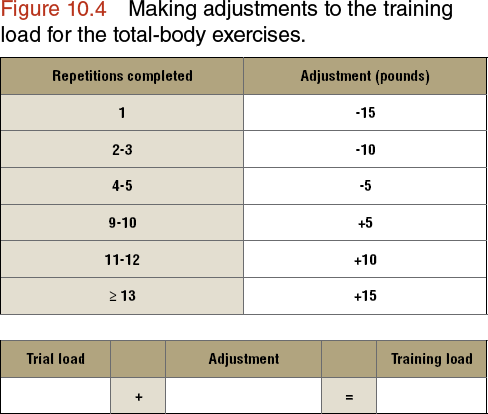
If you are new to weight training, you may have decided to wait until you are more experienced before adding the hang clean or push press to your workout. If you are more experienced and have added one or both of these exercises, you have taken your program to the next level. Using a proper grip, the correct body position, movement, and breathing patterns, and accurate warm-up and training loads will maximize your success.
After you have determined your training load for one or both total-body exercises and recorded it on your workout chart, you are ready to move on to step 11. This step provides instruction on how to approach your first workout now that you have selected all of the exercises for your program.
Before Taking the Next Step
Honestly answer each of the following questions. If you answer yes to all of the questions relevant to your level and exercise selection, you are ready to move on to step 11.
1. Have you selected a total-body exercise?
2. Have you recorded your exercise selection(s) on the workout chart?
3. Have you determined a warm-up and training load for the exercise(s) you selected?
4. Have you recorded the training load(s) on the workout chart?
5. Have you learned the proper technique for performing the exercise(s) you selected?